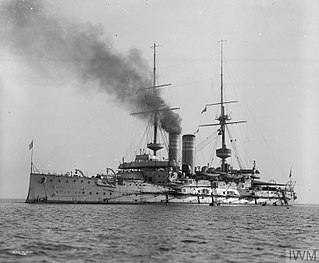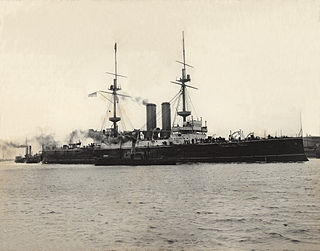
HMS Canopus was a pre-dreadnought battleship of the British Royal Navy and the lead ship of the Canopus class. Intended for service in Asia, Canopus and her sister ships were smaller and faster than the preceding Majestic-class battleships, but retained the same battery of four 12-inch (305 mm) guns. She also carried thinner armour, but incorporated new Krupp steel, which was more effective than the Harvey armour used in the Majestics. Canopus was laid down in January 1897, launched in October that year, and commissioned into the fleet in December 1899.

Admiral Charles Philip Yorke, 4th Earl of Hardwicke, PC was a British naval commander and Conservative politician.

HMS Irresistible—the fourth British Royal Navy ship of the name—was a Formidable-class pre-dreadnought battleship. The Formidable-class ships were developments of earlier British battleships, featuring the same battery of four 12-inch (305 mm) guns—albeit more powerful 40-calibre versions—and top speed of 19 knots of the preceding Canopus class, while adopting heavier armour protection. The ship was laid down in April 1898, was launched in December that year, and was completed in October 1901. Commissioned in 1902, she initially served with the Mediterranean Fleet until April 1908, when she was transferred to the Channel Fleet. Now outclassed with the emergence of the dreadnought class of ships, she entered service with the Home Fleet in 1911 following a refit. In 1912, she was assigned to the 5th Battle Squadron.

Admiral of the Fleet Sir George Rooke was an English naval officer. As a junior officer he saw action at the Battle of Solebay and again at the Battle of Schooneveld during the Third Anglo-Dutch War. As a captain, he conveyed Prince William of Orange to England and took part in the Battle of Bantry Bay during the Williamite War in Ireland.

HMS Albion was a pre-dreadnought battleship of the British Royal Navy and a member of the Canopus class. Intended for service in Asia, Albion and her sister ships were smaller and faster than the preceding Majestic-class battleships, but retained the same battery of four 12-inch (305 mm) guns. She also carried thinner armour, but incorporated new Krupp steel, which was more effective than the Harvey armour used in the Majestics. Albion was laid down in December 1896, launched in June 1898, and commissioned into the fleet in June 1901.
Eight ships of the Royal Navy have been named HMS Vengeance.

Vice Admiral Sir George Tryon, was a Royal Navy officer who died when his flagship HMS Victoria collided with HMS Camperdown during manoeuvres off Tripoli, Lebanon.

The Dardanelles operation was a failed assault by the British Royal Navy against the coastal fortifications of Constantinople. The operation was part of the Anglo-Turkish War.

HMS Cornwallis was a Duncan-class pre-dreadnought battleship of the Royal Navy. Built to counter a group of fast Russian battleships, Cornwallis and her sister ships were capable of steaming at 19 knots, making them the fastest battleships in the world. The Duncan-class battleships were armed with a main battery of four 12-inch (305 mm) guns and they were broadly similar to the London-class battleships, though of a slightly reduced displacement and thinner armour layout. As such, they reflected a development of the lighter second-class ships of the Canopus-class battleship. Cornwallis was built between her keel laying in July 1899 and her completion in February 1904.

HMS Rodney was a two-deck 90-gun second-rate ship of the line of the Royal Navy. Launched in 1833, she was broken up in 1884.

HMS Powerful was an 84-gun second rate ship of the line of the Royal Navy, launched on 21 June 1826 at Chatham Dockyard.

HMS Vengeance was a pre-dreadnought battleship of the British Royal Navy and a member of the Canopus class. Intended for service in Asia, Vengeance and her sister ships were smaller and faster than the preceding Majestic-class battleships, but retained the same battery of four 12-inch (305 mm) guns. She also carried thinner armour, but incorporated new Krupp steel, which was more effective than the Harvey armour used in the Majestics. Vengeance was laid down in August 1898, launched in July 1899, and commissioned into the fleet in April 1902.
HMS Burford was a 70-gun third rate ship of the line built at Woolwich Dockyard in 1677/79 as part of the Thirty Ships Programme of 1677. She fought in the War of the English Succession, including the Battle of Barfleur, before being rebuilt at Deptford in 1699, remaining as a 70-gun third rate. During the War of Spanish Succession she was mostly in the Mediterranean fleet and fought at the capture of Gibraltar and the Battle of Málaga in 1704 before being extensively repaired between 1710 and 1712 at Portsmouth Dockyard. Burford served in the Baltic in 1715 and 1717 before returning to the Mediterranean to fight the Spanish at the Battle of Cape Passaro in 1718. She was wrecked on the Italian coast in a storm on 14 February 1719.

HMS Eagle was a 70-gun third rate ship of the line of the Royal Navy, built at Portsmouth Dockyard during 1677/79. When completed she was placed in Ordinary for 10 years. She was in active commission during the War of the English Succession partaking in the Battle of Barfleur. She was rebuilt in 1699 at Chatham. She again played an active role in the early part of the War of Spanish Succession participating in the Capture of Gibraltar, and the Battle of Velez Malaga. She was wrecked in the Isles of Scilly in October 1707.

HMS Essex was a 70-gun third rate built by Sir Henry Johnson of Blackwall in 1678/79. During the War of the English Succession she fought in the last major action. She was rebuilt in 1699/1700. During the War of Spanish Succession she fought at Vigo Bay, the Capture of Gibraltar and Velez Malaga. She also fought at the Battle off Passero in 1718. She was rebuilt again in 1736-40. She was in action off Toulon in 1744. She was active in the Channel and against French ports during the Seven Years War. She fought at Quiberon Bay in 1759. She was wrecked in Quiberon Bay in November 1759.

HMS Orford was a 70-gun third-rate ship of the line of the Royal Navy, launched at Deptford in 1698. She carried twenty-two 24-pounder guns and four (18-pounder) culverins on the lower deck; twenty-six 12-pounder guns on the upper deck; fourteen (5-pounder) sakers on the quarter-deck and forecastle; and four 3-pounder guns on the poop or roundhouse.

Rear-Admiral Sir Thomas Louis, 1st Baronet was an officer of the Royal Navy who saw action during the American Revolutionary War and the French Revolutionary Wars. He was one of Horatio Nelson's "Band of Brothers" in the Mediterranean in 1798, commanding a ship at the Battle of the Nile. Later, he was second in command at the Battle of San Domingo, for which service he was made a baronet.

HMS Canopus was an 84-gun third rate ship of the line of the British Royal Navy. She had previously served with the French Navy as the Tonnant-classFranklin, but was captured after less than a year in service by the British fleet under Rear Admiral Horatio Nelson at the Battle of the Nile in 1798. Having served the French for less than six months from her completion in March 1798 to her capture in August 1798, she eventually served the British for 89 years.

Admiral Sir Joseph Sydney Yorke KCB was an officer of the Royal Navy. As a junior officer he saw action at the Battle of the Saintes in April 1782 during the American Revolutionary War. He commanded HMS Stag at the defeat of the Dutch fleet in August 1795 during the French Revolutionary Wars and went on to be First Naval Lord during the closing stages of the Napoleonic Wars.
George Pechell Mends was an English sailor and amateur artist.


















